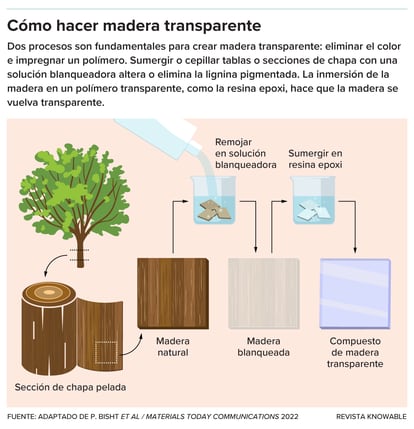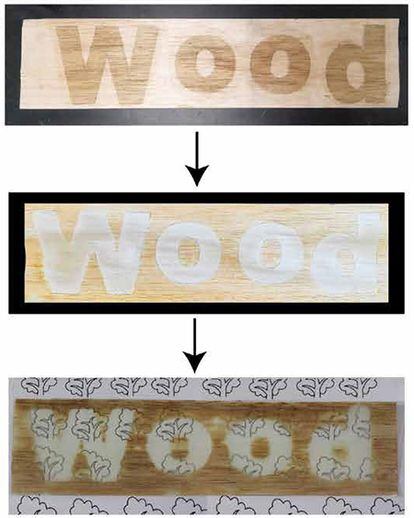30 years ago, a German botanist had a simple wish: to see the inner workings of woody plants without dissecting them. Siegfried Fink got create transparent wood bleaching the pigments of plant cells and published his technique in a magazine specialized in wood technology. The 1992 paper was the last word on transparent wood for more than a decade, until a researcher named Lars Berglund stumbled upon it.
Berglund was inspired by Fink’s discovery, but not for botanical reasons. The materials scientist, who works at Sweden’s KTH Royal Institute of Technology, has specialized in polymer composites and was interested in creating a more robust alternative to transparent plastic. And he was not the only one interested in the virtues of wood. Across the ocean, researchers at the University of Maryland were busy with a related goal: harnessing the power of wood for nontraditional purposes.
Now, after years of experiments, the research of these groups is beginning to bear fruit. Transparent wood could soon be used in super-durable smartphone screens, soft-light lamps, and even structural elements such as color-changing windows.
“I truly believe this material has a promising future,” says Qiliang Fu, a wood nanotechnologist at Nanjing Forestry University in China, who worked in Berglund’s lab as a graduate student.
The wood is made up of countless small vertical channels, like a tight bundle or bundle of straws held together with glue. These tube-shaped cells transport water and nutrients throughout the tree, and when the tree is cut down and the moisture evaporates, air pockets remain. To create transparent wood, scientists first have to modify or remove the glue, called lignin, that holds bundles of cells together and gives trunks and branches most of their earthy brown tones. After bleaching the color of the lignin or removing it, a milky white skeleton of hollow cells remains.
This skeleton remains opaque because the cell walls bend light differently than the air in the cell cavities, a value called the refractive index. By filling the air pockets with a substance such as epoxy resin, which bends light to a similar degree as cell walls, the wood becomes transparent.
The material the scientists worked with is thin: usually between a millimeter and a centimeter thick. But the cells create a robust honeycomb structure, and the tiny wood fibers are stronger than the best carbon fibers, says materials scientist Liangbing Hu, who leads the transparent wood research group at the University of Maryland at College Park. And with the added resin, clear wood outperforms plastic and glass: In tests that measure how easily materials fracture or break under pressure, clear wood was found to be about three times stronger than clear plastics like glass. plexiglass and about 10 times more than glass.
“The results are amazing, that a piece of wood can be as resistant as glass,” says Hu, who highlighted the wood characteristics transparent in the Annual Review of Materials Research of 2023.
The process also works with thicker wood, but vision through that substance is blurrier because it scatters more light. In their original 2016 studies, Hu and Berglund found that the millimeter sheets of resin-filled wood skeletons let 80 to 90 percent of light through. As the thickness approaches one centimeter, the passage of light decreases: Berglund’s group reported that 3.7 millimeters thick wood—approximately the thickness of two five-cent coins—let only the light pass through. 40% of the light.
The slim profile and strength of the material mean it can be a great alternative to products made with thin, easy-to-break cuts of plastic or glass, such as display screens. French company Woodoo, for example, uses a similar lignin removal process on its wood screens, but leaves some lignin to create a different color aesthetic. The company is adapting its recyclable, touch-sensitive digital displays to products such as car dashboards and billboards.
But most research has focused on transparent wood as an architectural element, with windows being an especially promising use, says Prodyut Dhar, a biochemical engineer at the Indian Institute of Technology, Varanasi. Transparent wood is a much better insulator than glass, so it could help buildings retain heat or keep it out. Hu and his colleagues have also used polyvinyl alcohol, or PVA — a polymer used in glues and food packaging — to infiltrate wood skeletons, making transparent wood that conducts heat at a faster rate. five times less than that of glass, the team reported in 2019 in Advanced Functional Materials.
And researchers are coming up with other tweaks to increase wood’s ability to retain or release heat, which would be useful for energy-efficient buildings. Céline Montanari, a materials scientist at RISE Research Institutes in Sweden, and her colleagues experimented with phase-change materials, which go from storing to releasing heat when they change from a solid to a liquid state, or vice versa. By incorporating polyethylene glycol, for example, scientists discovered that their wood could store heat when hot and release heat as it cooled, work they published in ACS Applied Materials and Interfaces in 2019.

Therefore, transparent wood windows would be stronger and help control temperature better than traditional glass, but the view through them would be hazy, more like frosted glass than a normal window. However, nebulosity could be an advantage if users want diffused light: since wood is thicker and stronger, it could be a light source that in turn supports part of the weight of a building, such as a roof that would provide a soft light to a room, says Berglund.
Hu and Berglund have continued to play with ways to confer new properties on transparent wood. About five years ago, Berglund and his colleagues at KTH and the Georgia Institute of Technology discovered that they could imitate smart windows, which can change from transparent to tinted to block visibility or the Sun’s rays. The researchers sandwiched an electrochromic polymer—a substance that can change color with electricity—between layers of transparent wood coated with an electrode polymer to conduct electricity . This is how it was created a changing wood panel from transparent to magenta when users pass a small electrical current through it.
More recently, the two groups have focused their attention on improving the sustainability of transparent wood production. For example, the resin used to fill wooden scaffolding is usually a petroleum-derived plastic product, so it is best to avoid its use, says Montanari. As a substitute, she and her colleagues invented a completely biological polymer, derived from citrus peels. The team first combined acrylic acid and limonene, a chemical extracted from lemon and orange peels that is found in essential oils. Then they impregnated delignified wood with it. Even with the fruity filler, the bio-based transparent wood maintained its mechanical and optical properties, withstanding about 30 megapascals of pressure more than regular wood and transmitting about 90% of light, the researchers reported in 2021 in Advanced Science.
Hu’s laboratory, for its part, has just published in Science Advances a greener method of lignin bleaching based on hydrogen peroxide and UV radiation, which further reduces the energy demand of production. The team brushed slices of wood between 0.5 and 3.5 millimeters thick with hydrogen peroxide and then held them in front of UV lamps to mimic the sun’s rays. The UV rays bleached the parts of the lignin that contain pigments, but they left the structural parts intact, which helped preserve more strength in the wood.

These more environmentally friendly approaches help limit the amount of toxic chemicals and fossil polymers used in production, but for now glass still has a lower environmental impact at the end of its life than transparent wood, according to an analysis de Dhar and his colleagues in Science of the Total Environment. Adopting greener production systems and scaling up manufacturing are two necessary steps to introduce transparent wood to mainstream markets, researchers say, but it will take time. However, they trust that it is possible and believe in its potential as a sustainable material.
“When you’re trying to achieve sustainability, you don’t just want to match the properties of fossil-based materials,” says Montanari. “As a scientist, I want to overcome it.”
Article translated by Debbie Ponchner.
This article originally appeared in Knowable in Spanisha nonprofit publication dedicated to making scientific knowledge available to everyone.
You can follow SUBJECT in Facebook, x and instagramor sign up here to receive our weekly newsletter.



